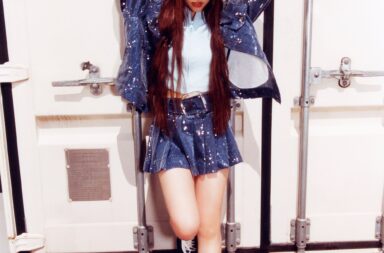 When most people think of the choreography of cute concept girl groups, they imagine trend gesture-focused choreography with simplistic moves, which can often be seen as inferior to the more difficult choreographies of many boy groups, resulting in the false perception that these groups lack strong dancers. However, some girl groups as of late have been challenging these assumptions. GFriend’s “Fingertip,” Oh My Girl’s “Coloring Book,” and Red Velvet’s “Rookie” all employ choreography that is markedly more physically demanding than what most have come to associate with cute concept girl groups. Yet groups such as Twice, Gugudan, and I.O.I demonstrate that trend gesture choreography has not completely died out.
When most people think of the choreography of cute concept girl groups, they imagine trend gesture-focused choreography with simplistic moves, which can often be seen as inferior to the more difficult choreographies of many boy groups, resulting in the false perception that these groups lack strong dancers. However, some girl groups as of late have been challenging these assumptions. GFriend’s “Fingertip,” Oh My Girl’s “Coloring Book,” and Red Velvet’s “Rookie” all employ choreography that is markedly more physically demanding than what most have come to associate with cute concept girl groups. Yet groups such as Twice, Gugudan, and I.O.I demonstrate that trend gesture choreography has not completely died out.
Trend gestures can be defined as certain movements or poses in a choreography that can easily be picked up by those who try to practice it. These types of dance moves can be effortlessly imitated by anyone, ranging from variety show hosts, idols making appearances on the aforementioned variety shows, little kids, the elderly, or even a sufficiently trained dog. The now well-known finger signs containing two interconnecting emulations of the letter T in the choreography of Twice’s “TT” is one of the most clear-cut models of a trend gesture. Even acknowledging the continuing prevalence of trend gesture choreographies in recent girl groups, however, there is still an unmistakable emerging pattern moving away from trend gestures and toward a harder type of choreography.
This new choreography trend does not indicate that girl group choreographies are becoming more identical to the choreography of boy groups. Nonetheless, it is still demonstrative of a shift in a more complex direction. A difference can be seen by those girl groups employing a more rigorous choreography and those that still rely on the trend gestures. As an illustration, DIA’s choreography for “Will You Go Out With Me” is considerably more challenging than Laboum’s “Hwi Hwi.” This is especially visible in the first chorus of DIA’s song, where the members move in a jump-rope motion and swing their legs back and forth. During the other choruses, they maneuver the stage through hop or skip motions.
Meanwhile in “Hwi Hwi,” the entire choreography consists mainly of hand gestures such as waving, the placing of the hands on the hips and chest, pointing, and posing. In the song’s intro and its pre-chorus, there is some brief intricate footwork. However, throughout most of the choreography, their foot movements consist of simply walking across the stage. In the verses of “Will You Go Out With Me,” the choreography becomes less arduous to accompany the softening of the song. The girls’ moves inch more toward positions and posing but never quite gets into full trend gesture mode. The choreography in the verses of “Hwi Hwi,” like the one for “Will You Go Out With Me,” becomes simpler.
However, in DIA’s song, there are rarely any moments where any of the girls are completely still, while in “Hwi Hwi” some of the members are unmoving for considerable amounts of time during the verses. From comparing these two choreographies, one can easily see that DIA’s choreography is more physically strenuous than Laboum’s, and therefore, more difficult. This is not to say that either choreography is better than the other. However, this comparison does demonstrate that there is, indeed, a trend towards a more dynamic type of choreography.
Likewise, in the choreography of the intro to GFriend’s “Fingertip,” the girls jump and spin several times along with performing substantially demanding arm and hip actions. Throughout the choruses in the song, sharp arm and leg moves prevail. Red Velvet’s “Rookie” contains a a similarly high energy choreography involving a great deal of jogging and crisp arm movements. All three dances share a common quality, being that the girls are almost always in constant motion. As alluded to earlier, DIA is only one of the notable girl groups where the manifestation of the more complex choreography trend is visible, while Laboum is an example of a girl group that still relies chiefly on trend gestures.
 At the same time, a softer, less physically demanding kind of choreography is not necessarily a poorly made one; it is often more suited to the song styles and cute image of the girl groups that employ them. Thus, in its own way, this type of choreography can still be objectively considered as good. Case in point: Cosmic Girls’ “Secret” doesn’t consist of the world’s most laborious choreography; in fact, a parallel can be drawn from from their choreography to Laboum’s. For considerable portions of the song, a large amount of girls in the group stays completely still, and the usage of hand movements and posing is dominant in the choreography. The legwork is not particularly complicated either.
At the same time, a softer, less physically demanding kind of choreography is not necessarily a poorly made one; it is often more suited to the song styles and cute image of the girl groups that employ them. Thus, in its own way, this type of choreography can still be objectively considered as good. Case in point: Cosmic Girls’ “Secret” doesn’t consist of the world’s most laborious choreography; in fact, a parallel can be drawn from from their choreography to Laboum’s. For considerable portions of the song, a large amount of girls in the group stays completely still, and the usage of hand movements and posing is dominant in the choreography. The legwork is not particularly complicated either.
However, Cosmic Girls’ use of interesting formations adds an element of uniqueness to the dance, along with helping the choreography gain a more eye-catching characteristic. The group’s large amount of members allows for a variety of striking formations. This extensive usage of formations to jazz up the choreography makes sense in the context of this song, as the song’s slow beat would make a more complex or hard-hitting choreography look out of place. It was a good choice to use formations to make a simpler choreography look more interesting rather than using a more difficult choreography right off the bat.
Furthermore, Cosmic Girls has a cute concept with a large variety of more down tempo songs the dark image and a rock-based musical style that pairs well with powerful moves seen in Dreamcatcher‘s dances. Consequently, it would follow that their choreography is tailored to their concept and general genre of music that they perform due to said concept.
Nonetheless, an overemphasis on formations could have its downsides as well. Formations can be seen as a tool to obscure the weaker dancers’ shortcomings, as they make choreographies seem more complex than they actually are and place less emphasis on showcasing the individual dancers’ skills by shifting the focus to the movements of the group as a whole. This can create the illusion that the members in the group are less skilled dancers than they actually are, thereby undermining the allure of the group as a whole. The merits and disadvantages of using formations should both be considered when praising and critiquing choreographies.
Although there is still a long way to go for most girl group choreographies in terms of their difficulty in comparison to certain boy groups, this recent trend might be an indicator of a significant change for the choreography of girl groups in the future. Increasing the difficulty of cute concept girl groups’ choreographies can give opportunities for the more skilled dancers to really shine. At the same time, a discreet usage of formations can add further touches of interest to these choreographies. As their dances change, cute concept girl groups can gradually break out of their creative box, in which they were subject to more simple and trend gesture-centric choreography, while simultaneously changing the notion that they are weaker dancers.
(YouTube [1][2][3], Images via Source Music, Starship Entertainment, WM Entertainment.)


